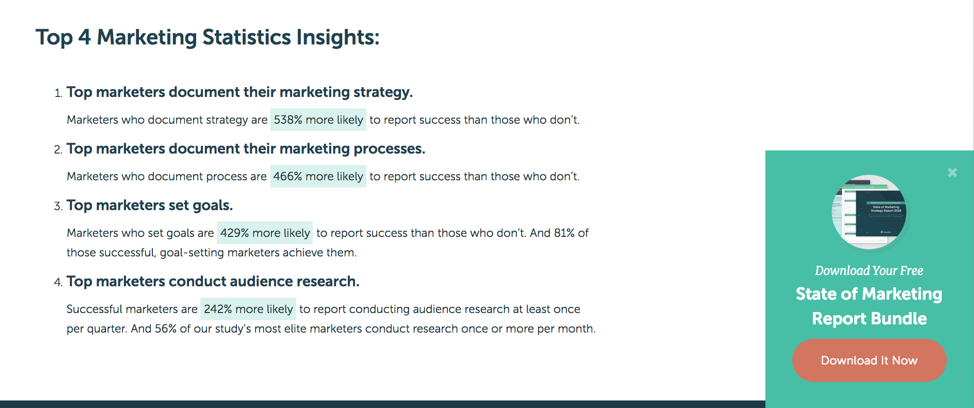Highlight key stats in click-to-tweet format When you write about your research, make it as easy as possible for people to share. Here is an example from CMI’s annual B2B content marketing research. Yes, it does take some time to reach out to influencers, but it’s worth it. (Or, if this is an annual report, understand who covered your previous findings.) My business partner Clare McDermott recently shared some ideas for dataviz to incorporate into your marketing, including original research. That’s easy: not pitching articles about the findings to other publications. Of course, it makes sense to cover your research on your blog as it can be a traffic magnet, but you also have an opportunity to get in front of new audiences if you tailor and pitch posts to other publications. When I was (coincidentally) emailing Heike about research Salesforce published, I received this out-of-office message: Make it easy for people to reach out to you Your research is story-worthy, and you want people to write about it, interview you, etc. I love talking to people about their research projects (please add a comment below or reach out anytime if you are interested in chatting). Journalists, bloggers, podcast hosts, and more may want to talk to you as well, but if you don’t make it easy, they may quickly move on.

Did you know Andy Crestodina spends 150 hours on his annual blogger study? (This truly blew my mind – and it’s just one of the many insights I gleaned from a recent podcast with Andy on the Inbound Success podcast on original research. Absolutely worth a listen!)
While I can’t quantify how much time I have invested on any given research project, it’s somewhere in the ballpark of heaps to a truckload. Putting in the time – and money – makes sense because research works, but you can do much more beyond publishing the initial findings.
To that end, I have studied how other marketers approach research and talked with those “in the trenches.” My goal is to learn from those who recently started publishing research as well as those who have been doing it awhile.
Today, I’m sharing a collection of solutions to missed opportunities that anybody doing their own original research can incorporate.
Have an ungated version of your research
The other week, I happened upon some strong research that had few shares or backlinks. When I dug in, I quickly realized the main research page was a gated form that teased the findings but offered little substance.
Of course, the company’s goal may be subscribers, but it’s tough to get many subscribers if people aren’t getting to your gated page.
I’ll let you in on a little secret, too: Some sites won’t link to gated pages because it feels promotional. Even if your research is fabulous, you may lose if you don’t have an open-access, useful page.
Don’t miss an opportunity to share your research findings wide and far, even if you are focused on leads. If you tell your story well in a blog post or article, people will want to read more – and they will be more apt to complete your form.
TIP: If your primary goals are brand awareness, traffic, or backlinks, forgo the gate altogether. And take advantage of this next opportunity …
Create a call to action for your research
Chances are, your research will uncover key challenges or things your audience isn’t doing but should be. Can you hear your readers practically screaming, “We need help!”?
Be proactive and figure out what content you can publish to help your readers with their biggest struggles – and use that as a call to action for your research.
For instance, the majority of Content Marketing Institute research is ungated. A key challenge was identified in that research and a gated guide was created on how to document a content marketing strategy. It’s been downloaded thousands of times.
Or, take this example from CoSchedule. Its State of Marketing report landing page uncovers key takeaways from the research – and the gated content bundles the report with documents and templates that align with these ideas: personas, a marketing plan, and a content plan.

Publish your research on SlideShare
This next idea comes from Hailley Griffis at Buffer, which recently published The State of Remote Work in 2018. When I asked what surprised her about the process – or what worked better than expected – she had one word: SlideShare.
She had not planned to put the research on the SlideShare platform, but it was an easy thing to try. She was surprised how much traffic it generated – more than 25,000 views as of this writing.
TIP: If you gate your research, you may be hesitant to release your research on SlideShare. However, most people don’t search for an ungated version if they come across a landing page with the gated version. (Do you?) Chances are different people will stumble across your research on SlideShare. If you aren’t certain, run a short experiment to see what happens.
Alternatively, if this SlideShare idea makes you or your management squeamish, create a skinny version for SlideShare that offers valuable information with a call to action to download the full version of your research.
Highlight key stats in click-to-tweet format
When you write about your research, make it as easy as possible for people to share. CMI’s Blog and Community Operations Manager Lisa Dougherty adds Better Click to Tweet posts with key stats or insights in every article, but it works especially well in research articles.
Here is an example from CMI’s

COMMENTS